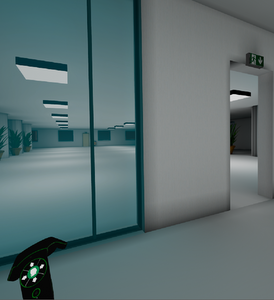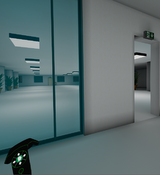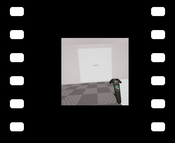Information
- Publication Type: Master Thesis
- Workgroup(s)/Project(s):
- Date: February 2018
- Date (Start): February 2017
- Date (End): 27. February 2018
- Diploma Examination: 27. February 2018
- First Supervisor:
- Keywords: virtual reality, vision impairment simulation, emergency lighting
Abstract
To facilitate the safe evacuation of buildings, escape-route safety signs need to be placed along the whole escape route such that they are legible for building occupants. While standards and legal requirements provide suggestions on how to select and place safety signs to achieve this, they do not provide sufficient considerations concerning people suffering from vision impairments. A main cause of vision impairment are age-related eye diseases, with the most common symptom being the loss of visual acuity.We investigate the influence of visual acuity on the ability to recognize safety signs using a novel methodology, evaluating existing standards concerning vision impairments: We calibrate the visual acuity of the test subjects to the same level via a standardized medical test in VR. This is achieved by using test subjects with normal or corrected vision and simulating the impairment in VR. Furthermore, we present a tool for lighting designers which enables them to check their designs considering maximum recognition distances to investigate problematic areas along an escape route.
Using our novel user-study methodology, we determined the recognition distances for safety signs, observed under two different levels of visual acuity and varying observation angles. In addition, we determined the impact of the HTC Vive’s HMD on the visual acuity achievable in VR. We conclude that the existing standards fail to correctly estimate the maximum recognition distances of safety signs for observers suffering from reduced visual acuity.
Additional Files and Images
Weblinks
No further information available.BibTeX
@mastersthesis{Bauer_Dominik_2018_VR,
title = "Evaluation of the Recognition Distances of Safety Signs in
VR Considering Vision Impairments",
author = "Dominik Bauer",
year = "2018",
abstract = "To facilitate the safe evacuation of buildings, escape-route
safety signs need to be placed along the whole escape route
such that they are legible for building occupants. While
standards and legal requirements provide suggestions on how
to select and place safety signs to achieve this, they do
not provide sufficient considerations concerning people
suffering from vision impairments. A main cause of vision
impairment are age-related eye diseases, with the most
common symptom being the loss of visual acuity. We
investigate the influence of visual acuity on the ability to
recognize safety signs using a novel methodology, evaluating
existing standards concerning vision impairments: We
calibrate the visual acuity of the test subjects to the same
level via a standardized medical test in VR. This is
achieved by using test subjects with normal or corrected
vision and simulating the impairment in VR. Furthermore, we
present a tool for lighting designers which enables them to
check their designs considering maximum recognition
distances to investigate problematic areas along an escape
route. Using our novel user-study methodology, we
determined the recognition distances for safety signs,
observed under two different levels of visual acuity and
varying observation angles. In addition, we determined the
impact of the HTC Vive’s HMD on the visual acuity
achievable in VR. We conclude that the existing standards
fail to correctly estimate the maximum recognition distances
of safety signs for observers suffering from reduced visual
acuity.",
month = feb,
address = "Favoritenstrasse 9-11/E193-02, A-1040 Vienna, Austria",
school = "Institute of Computer Graphics and Algorithms, Vienna
University of Technology ",
keywords = "virtual reality, vision impairment simulation, emergency
lighting",
URL = "https://www.cg.tuwien.ac.at/research/publications/2018/Bauer_Dominik_2018_VR/",
}

 poster
poster thesis
thesis




